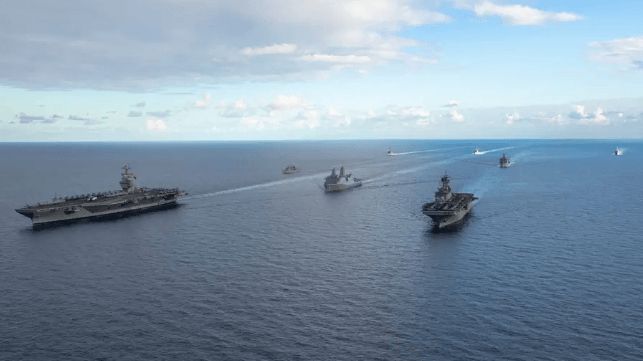Carrier USS Ford Finally Heads Home After Extended Mission in East Med

The first-in-class carrier USS Gerald R. Ford has capped off an eight-month extended deployment in the Mediterranean and is heading home at last. After years of teething difficulties, the high-tech carrier has finally demonstrated that she can serve a deterrence function.
USS Ford is wrapping up her first full overseas deployment, six years after her delivery from Huntington Ingalls Newport News Shipyard. The deployment began in March 2023 when Ford left Norfolk for Europe, where she was scheduled to take up a patrol in the Mediterranean. Ford sailed with an air wing of F/A-18 Super Hornet strike fighters, but without the new stealth F-35, which she is not yet equipped to support.
In October, after the deadly Hamas terrorist attacks on Israel, the White House diverted Ford to the Eastern Mediterranean, where she held station and stayed at the ready to deter Iranian proxy forces in Lebanon and Syria. That mission has been partially successful: though Iranian-backed militant groups have launched limited attacks on U.S. forces in the region, the paramilitary organization Hezbollah and its sponsors in Tehran have so far refrained from starting a full-scale war with Israel.
USS Ford was scheduled to be relieved by the carrier USS Dwight D. Eisenhower, but the growing portfolio of threats in the Mideast prompted the Defense Department to keep both carriers in the region. Instead, Eisenhower headed through the Suez Canal and the Strait of Bab el-Mandeb to hold station in the Arabian Sea, where she would be positioned to respond to Iranian provocations. Eisenhower later returned west to the Gulf of Aden in order to support the air-defense/policing mission in the Red Sea, and her strike fighters have assisted in shooting down attack drones launched by Houthi militants in Yemen.
With Eisenhower preoccupied elsewhere, Ford had no immediate relief in sight. The Pentagon formally extended the carrier's deployment twice in order to maintain coverage in the region; except for a few stopovers in Souda Bay, Ford remained on station at sea.
On Monday, as Israel announced a scaleback of its operations in Gaza, the Navy announced that Ford would be headed home. She and her escorts will be replaced on station by the Bataan Amphibious Ready Group (ARG), consisting of USS Bataan, USS Mesa Verde and USS Carter Hall. Bataan and Carter Hall had been in the Red Sea until last week, and though the Houthi threat to shipping remains, they are needed in the Med. The "big deck" amphib USS Bataan is a miniature carrier in her own right, and sails with a squadron of Harrier jump-jets (in addition to other assets).
The combined naval force carried out one last photo exercise before Ford's departure, with both task forces and their escorts supplemented by allied naval vessels.

that matters most
Get the latest maritime news delivered to your inbox daily.
The extended deployment was a test for USS Ford. The Navy accepted delivery of the new carrier in 2017, but additional post-delivery installation and commissioning work took more than four years, adding to the vessel's unprecedented $13 billion acquisition cost. As recently as last January, the Pentagon's testing watchdog warned that there might still be work to do.
However, the Navy has suggested that Ford is performing well. In August, she joined in an exercise with NATO partners, and the Navy said that the carrier and crew carried out their roles as intended.
